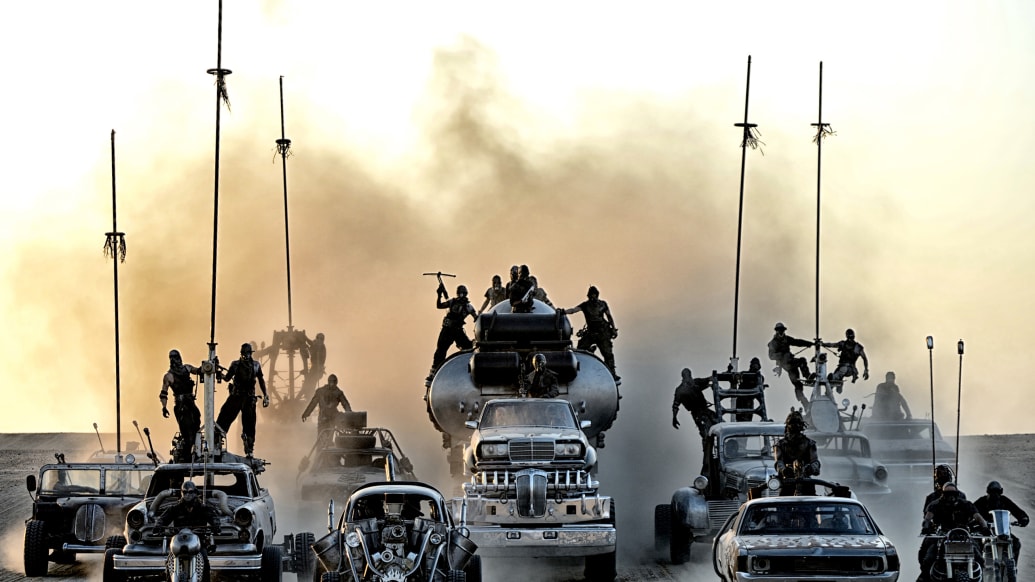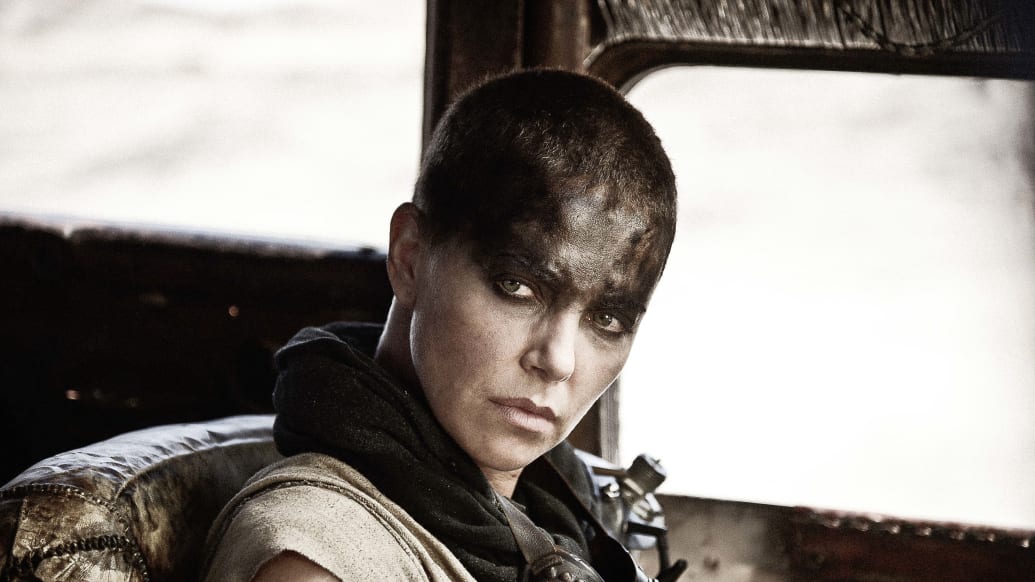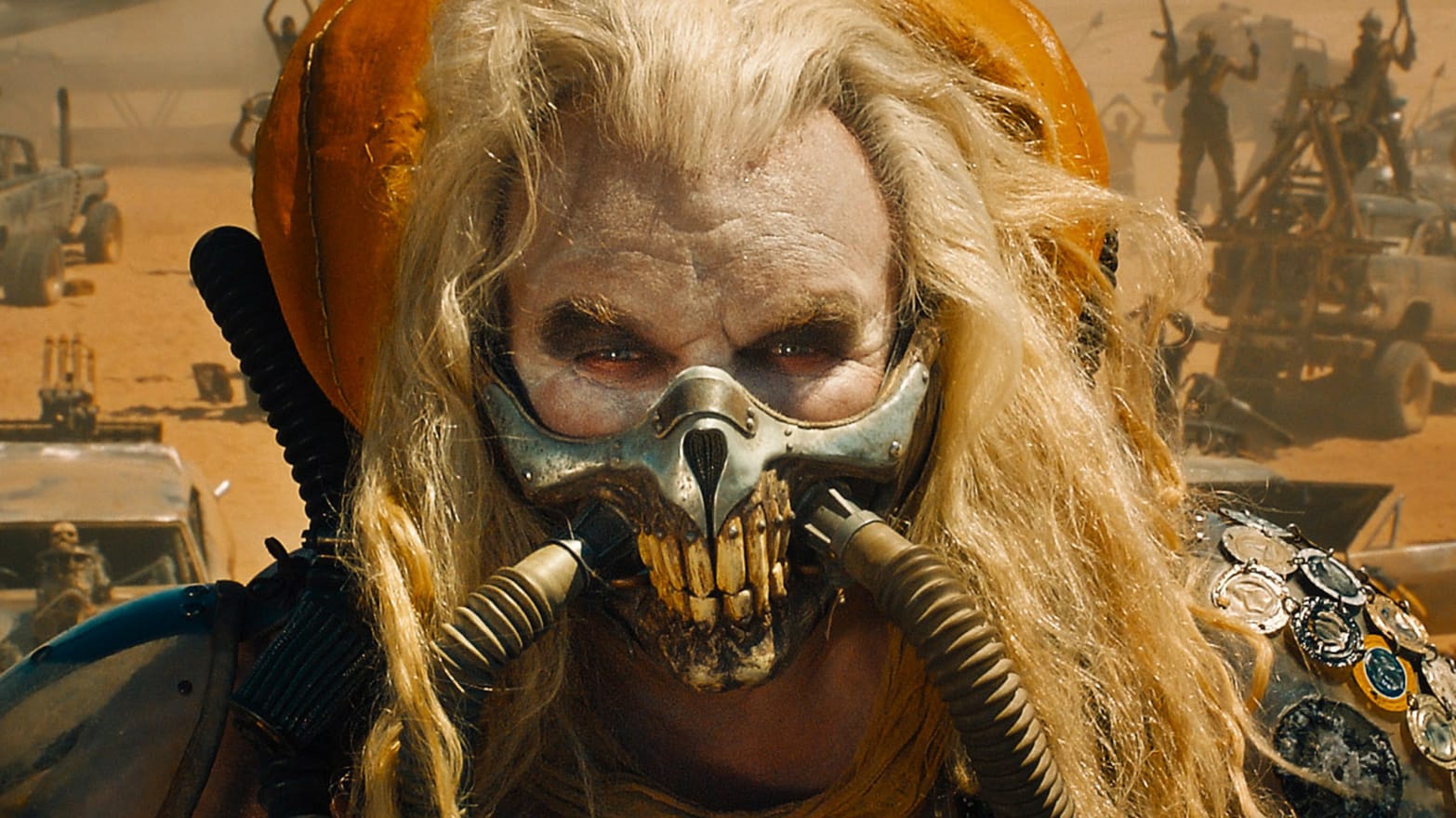It was the Keith Richards of movie projects—no matter what insane obstacles came in its path, be it 9/11, Mel Gibson’s drunken anti-Semitic meltdown, the passing of Heath Ledger, the writers strike, fantastical desert showers, or alleged warring co-stars, it motored along, refusing to die.
This weekend, Mad Max: Fury Road crash-lands into multiplexes. The first entry in the Mad Max franchise since 1985’s Beyond Thunderdome, it stars Tom Hardy as Max Rockatansky, a muted rebel in a barren futuristic wasteland who’s lost his family and wheels. After escaping the albino War Boys, he aligns himself with rogue warrior Imperator Furiosa (Charlize Theron) on a quest to transport five pregnant slave-wives from the clutches of Immortan Joe (original cast member Hugh Keays-Byrne), a water-hoarding masked tyrant who promises his sickly acolytes salvation in Valhalla, to a desert oasis.
Max, Furiosa, the wives, and Nux (Nicholas Hoult), a War Boy defector, find themselves packed into a War Rig—a tricked-out heavy haul truck—barreling through the post-apocalyptic hellscape and chased by a rabid convoy of fire-breathing vehicles boasting pole-swingers, spear-throwers, and a chain gun-wielding giant known as “Rictus Erectus.” Their arrival is signaled by iOTA, a metalhead shredding a flamethrower-guitar in front of a giant stack of speakers.
“He’s logical to that world,” director George Miller says of iOTA. “Pre-modern communications, there was always the music of war—the bugle, horns, bagpipes, drummers. Every war culture had some sound to signal the troops… ours is just weaponized, so it’s a flamethrower as well.”
The idea for the original Mad Max began with Miller’s previous career as a doctor in an emergency room in Sydney, Australia, where he observed many victims of car accidents. He’d also lost several friends to car crashes as a teen. And, unlike the $150 million Fury Road, the first Mad Max was made on a shoestring budget of $350,000.
“People say, ‘You came up with the first post-apocalyptic world,’ but the truth was in the first Mad Max movie we couldn’t afford to shoot in a modern day street,” says Miller. “You needed extras, buildings, and all these vehicles, so we shot it in deserted backstreets and decrepit buildings that cost us nothing. To explain this disintegrating world, I just put in a caption, ‘A few years from now…,’ so it came out of necessity. By the time we got to Road Warrior, we realized that we’d tapped into some universal archetype and were much more conscious of this post-apocalyptic world inspired by the oil wars.”
Indeed, the dystopian world of Mad Max is steeped in allegory, with 1981’s The Road Warrior inspired by the oil crises of the ‘70s.
“I’d lived in a very lovely and sedate city in Melbourne, and during OPEC and the extreme oil crisis, where the only people who could get any gas were emergency workers, firemen, hospital staff, and police, it took ten days in this really peaceful city for the first shot to be fired, so I thought, ‘What if this happened over ten years?’” Miller recalls. Fury Road, on the other hand, is set in a future society with dwindling resources—namely water—and also concerns women’s ownership over their bodies, with Immortan Joe’s five slave-wives escaping their birthing lairs and scrawling all over the walls, “We are not things.” Given the drought in California and America’s constant clash over reproductive rights, the film’s themes couldn’t be timelier.

“We’re almost a desert, Australia, so it’s a crisis just like in California,” Miller says. “In the mid-aughts, I was in India and first heard the term ‘water wars’—that people in Kashmir and other places were fighting over water. Sadly, things don’t change a lot. In terms of the commodification of women, we’re becoming more and more aware of that. But everyone in this movie is a commodity—they wear the brand of Immortan Joe on the back of their necks.”
Over the last ten months, Fury Road has been riding a wave of strident buzz. When the first footage of the film unspooled at last year’s Comic-Con, it prompted then-Sony Pictures president Amy Pascal to fire off a series of giddy emails—later exposed in the Sony hacks—branding it “the greatest trailor [sp] ever” and declaring “we need guys like George Miller to make movies for us.” Miller, of course, is the 70-year-old medical doctor turned visionary filmmaker who’s architected the Mad Max universe, from the 1979 original to The Road Warrior and on to Fury Road.
But it wasn’t always that way.
It’s taken 17 years for Mad Max: Fury Road to travel from the mind of Miller—a vision back at an L.A. crosswalk of “a continuous chase” involving “human cargo of five wives racing across the wasteland and fleeing a tyrannical warlord”—to the big screen. And for a while, it seemed like the movie gods had it out for the plagued production.
Fury Road was set to begin shooting back in 2001, but filming was stalled due to the September 11 attacks, which caused the American dollar to plummet against the Australian dollar.
“We were financed in American dollars and shooting in Australian dollars, and we lost 25 percent of our budget,” Miller says. “We looked to see what we could cut, but it would have compromised the movie.”He adds, “When 9/11 happened, it extended three months the time it would take to ship your equipment—these large containers of gear and all the vehicles—and the insurance got higher. We were geared up to do Happy Feet after Fury Road, so we had to start on that.”
If that weren’t enough, Mel Gibson was set to reprise his role as Max Rockatansky, but had to exit the big-budget project after his well-publicized anti-Semitic tirade. And to answer your question, no, Gibson was never slated to cameo in Fury Road.
“Never for Mel,” says Miller. “It would be like having Sean Connery turning up in Daniel Craig’s James Bond movie. It would pull everyone out of the movie when you’re trying to get them into it.”
Then in 2006, during production on his Oscar-winning animated feature Happy Feet, Miller began courting fellow Aussie Heath Ledger for the role of Max.
“Every time Heath [Ledger] would come through Sydney, he’d call in and we’d chat about Max,” says Miller. “He had that same thing that Mel and Tom Hardy have—that maleness, charisma, and restless energy, which you need to play a relatively still character. The world lost someone great when he went. Tom was the next to walk through the door that had that vibe.”
Hardy announced his casting in June 2010. The plan at the time was to shoot two Mad Max films back-to-back: Mad Max: Fury Road and Mad Max: Furiosa, with the first being a live-action flick and the second an anime.
“We were gonna do an anime of Furiosa, like Akira,” Miller says. “We were going to shoot in a place called Broken Hill in Australia out in the Outback, and it rained for the first time in 15 years, and what was the flat red earth of the wasteland was now literally a flower garden and the great salt lakes in the center of Australia had pelicans and frogs in them.”

So, Miller moved production from Australia to Namibia, and filming finally began in July 2012. In lieu of a shooting script, Miller collaborated with comic book artist Brendan McCarthy on storyboarding the entire film, ending up with a total of 3,500 panels—nearly the same number of shots in Fury Road. Nearly all of the effects in the film were achieved without the use of CG—including the pole-swinging sequences, achieved by recruiting Cirque du Soleil performers and Olympic gymnasts.
“The pole-swinging I never thought we could achieve,” says a chuckling Miller. “I never thought we could actually move the poles on the cars, and then one day I looked up and there were eight of them coming out of the desert swinging about. I thought, ‘Oh my god, we did it.’ And we got Tom up there! He’s afraid of heights, but he did it anyway. When he’s hanging upside down between the wheels of a War Rig as it’s hurtling through the desert, that’s Tom Hardy inches off the ground being suspended by two big cables.”
In October, however, reports circulated that the film had fallen weeks behind schedule leading its studio, Warner Bros., to send its then-president Jeff Robinov out to the Namibian set to oversee production.
In addition, rumors spread that Hardy had become very difficult on set, driving co-star Theron nuts with his intense method-acting routine. The alleged feud was addressed in a 2014 Esquire profile of Hardy. “That on the set of Mad Max: Fury Road, Charlize Theron found him weird and scary and wanted him kept away from her. That when the head of Warner Bros. went to visit the Mad Max set in Namibia, he offered to let Hardy spar with him so that he could work out his issues,” wrote Tom Junod.

“We fuckin’ went at it, yeah,” Theron recently told Esquire. “And on other days, he and George went at it. It was the isolation, and the fact that we were stuck in a rig for the entire shoot. We shot a war movie on a moving truck—there’s very little green screen. It was like a family road trip that just never went anywhere. We never got anywhere. We just drove. We drove into nothingness, and that was maddening sometimes.” Despite their on set drama over the 130-day shoot, the two have since buried the hatchet. Theron even showed the Esquire scribe a gift Hardy left for her in her trailer: a self-portrait Hardy painted with an inscription that read, “You are an absolute nightmare, BUT you are also fucking awesome. I’ll kind of miss you. Love, Tommy.”
And just this week, Hardy issued a public apology to Miller during a press conference for the film at Cannes: “I have to apologize to you because I got frustrated and there is no way that George could have explained what he conceived in the sand while we were out there… I knew [Miller] was brilliant, but I didn’t know how brilliant until I saw it.”
Indeed, Mad Max: Fury Road is a modern day masterpiece; a relentlessly volatile, immaculately staged, and unabashedly feminist feature-length car chase.
Miller claims he doesn’t know whether he’ll helm any sequels, although acknowledges that Hardy is “signed on for three more films,” and that they’ve “written backstories for everything,” including a Max Rockatansky novella and the aforementioned Mad Max: Furiosa screenplay. For now, though, he’s just happy to see his remodeled classic shine on the silver screen.
“It’s a film you couldn’t kill with a stick, you know?” he says with a smile. “It just kept on coming back!”

